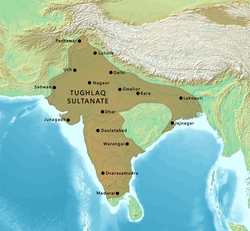
Back سلطنة دلهي Arabic Sultanatu de Delhi AST Dehli sultanlığı AZ دهلی سولطانلیغی AZB Дели солтанлығы BA Дэлійскі султанат BE Делхийски султанат Bulgarian दिल्ली सल्तनत BH দিল্লি সালতানাত Bengali/Bangla Sultanat de Delhi Catalan
The English used in this article or section may not be easy for everybody to understand. (November 2024) |
Sultanate of Delhi | |||||||||||||||||||||||||
|---|---|---|---|---|---|---|---|---|---|---|---|---|---|---|---|---|---|---|---|---|---|---|---|---|---|
| 1206–1526 | |||||||||||||||||||||||||
 Delhi sultanate at its greatest extent under Tughlaq dynasty | |||||||||||||||||||||||||
| Status | Sultanate | ||||||||||||||||||||||||
| Capital | |||||||||||||||||||||||||
| Official languages | |||||||||||||||||||||||||
| Religion | State religion Sunni Islam Others Hinduism (majority), Jainism, Buddhism, Christianity, Zoroastrianism | ||||||||||||||||||||||||
| Government | Monarchy | ||||||||||||||||||||||||
| Sultan | |||||||||||||||||||||||||
• 1206–1210 | Qutb ud-Din Aibak (first) | ||||||||||||||||||||||||
• 1517–1526 | Ibrahim Lodi (last) | ||||||||||||||||||||||||
| Legislature | Corps of Forty (1211–1266) | ||||||||||||||||||||||||
| Historical era | Medieval India | ||||||||||||||||||||||||
| 25 June 1206 | |||||||||||||||||||||||||
| 21 April 1526 | |||||||||||||||||||||||||
| Area | |||||||||||||||||||||||||
• 1312 | 3,200,000 km2 (1,200,000 sq mi)[8] | ||||||||||||||||||||||||
| Population | |||||||||||||||||||||||||
• 1500 estimate | 101,000,000[9] | ||||||||||||||||||||||||
| Currency | Taka | ||||||||||||||||||||||||
| |||||||||||||||||||||||||
| Today part of | |||||||||||||||||||||||||
The Delhi Sultanate (دلی سلطنت), or Sultanate-e-Hind (سلطنتِ ہند or Empire of India) or Sultanate-e-Dilli (سلطنتِ دلی or Empire of Delhi) were the Sunni Islamic Persian/Hindavi-speaking dynasties of Turkic, Indic[10][11] and Pashtun origin,[12] which were controlling most of the Indian subcontinent from 1210 to 1526. Most of these dynasties ruled from Delhi. This includes the Slave dynasty (1206-90), the Khilji dynasty (1290-1320), the Tughlaq dynasty (1320-1413), the Sayyid dynasty (1414-51), and the Lodi dynasty (1451-1526). The reign of the Delhi Sultans ended after Ibrahim Lodi of the Lodi Dynasty was defeated and killed by Babur in the Battle of Panipat.[13]
- ↑ Grey flag with black vertical stripe according to the Catalan Atlas (c. 1375):
 in the depiction of the Delhi Sultanate in the Catalan Atlas
in the depiction of the Delhi Sultanate in the Catalan Atlas
- ↑ Kadoi, Yuka (2010). "On the Timurid flag". Beiträge zur islamischen Kunst und Archäologie. 2: 148. doi:10.29091/9783954909537/009. S2CID 263250872.
...helps identify another curious flag found in northern India – a brown or originally silver flag with a vertical black line – as the flag of the Delhi Sultanate (602–962/1206–1555).
- ↑ Note: other sources describe the use of two flags: the black Abbasid flag, and the red Ghurid flag, as well as various banners with figures of the new moon, a dragon or a lion.Qurashi, Ishtiyaq Hussian (1942). The Administration of the Sultanate of Delhi. Kashmiri Bazar Lahore: SH. MUHAMMAD ASHRAF. p. 143.
Large banners were carried with the army. In the beginning, the sultans had only two colours : on the right were black flags, of Abbasid colour; and on the left, they carried their colour, red, which was derived from Ghor. Qutb-ud-din Aibak's standards bore the figures of the new moon, a dragon or a lion; Firuz Shah's flags also displayed a dragon.
Jha, Sadan (8 January 2016). Reverence, Resistance and Politics of Seeing the Indian National Flag. Cambridge University Press. p. 36. ISBN 978-1-107-11887-4., also "On the right of the Sultan was carried the black standard of the Abbasids and on the left the red standard of Ghor." in Thapliyal, Uma Prasad (1938). The Dhvaja, Standards and Flags of India: A Study. B.R. Publishing Corporation. p. 94. ISBN 978-81-7018-092-0. - ↑ Eaton, Richard Maxwell (2015). The Sufis of Bijapur, 1300–1700: Social Roles of Sufis in Medieval India. Princeton University Press. pp. 41–42. ISBN 978-1-4008-6815-5.
- ↑ Alam, Muzaffar (1998). "The pursuit of Persian: Language in Mughal Politics". Modern Asian Studies. 32 (2). Cambridge University Press: 317–349. doi:10.1017/s0026749x98002947. S2CID 146630389.
Hindavi was recognized as a semi-official language by the Sor Sultans (1540–1555) and their chancellery rescripts bore transcriptions in the Devanagari script of the Persian contents. The practice is said to have been introduced by the Lodis (1451–1526).
- ↑ "Arabic and Persian Epigraphical Studies - Archaeological Survey of India". Asi.nic.in. Archived from the original on 29 September 2011. Retrieved 29 January 2018.
- ↑ Jackson 2003, p. 28.
- ↑ Turchin, Peter; Adams, Jonathan M.; Hall, Thomas D. (December 2006). "East-West Orientation of Historical Empires Archived 17 May 2016 at the Portuguese Web Archive" (PDF). Journal of World-Systems Research. 12 (2): 222–223. ISSN 1076-156X. Archived (PDF) from the original on 7 July 2020. Retrieved 7 July 2020.
- ↑ Cite error: The named reference
ggdc.netwas used but no text was provided for refs named (see the help page). - ↑ Easton, Richard M. (2019). India in the Persianate Age: 1000–1765. University of California Press. p. 105. ISBN 978-0520325128.
The career of Khizr Khan, a Punjabi chieftain belonging to the Khokar clan, illustrates the transition to an increasingly polycentric north India.
- ↑ Orsini, Francesca; Sheikh, Samira (2014). After Timur Left: Culture and Circulation in Fifteenth-century North India. Oxford University Press. ISBN 978-0-19-945066-4.
- ↑ Ramananda Chatterjee (1961). The Modern Review. Vol. 109. Indiana University. p. 84.
- ↑ Chandra, Satish (2005). Medieval India: From Sultanat to the Mughals Part – II. Har-Anand Publications. pp. 30–31. ISBN 978-81-241-1066-9.
